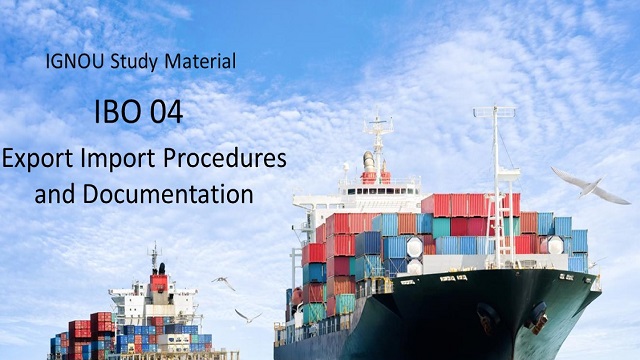Download Important Questions Of IBO 04 Export Import Procedure and Documentation
Here, we are providing some Important Questions and Answers of IBO 04 Export Import Procedures and documentation. These questions are important for students, going to appear their term end exams.Q1. Explain various types of Commercial Documents used in Exports.
Ans.: Commercial
Documents
Commercial documents, also known as shipping documents, enable the exporter and the importer to discharge their obligations under an export contract.
- Commercial Invoice: Commercial Invoice is a document of contents that describes details of goods sent by exporter. It is the statement of account, which must contain identification marks and numbers, description of goods and quantity of goods. Every shipment has identification marks, which identify the cargo with various documents. These are private marks, which are made on the packages. These marks could be either in the form of symbols (say, a star, triangle, rectangle, etc.) or numerical.
- Bill of Landing: Bill of landing is a transport documents issued by Shipping Company or its agents, stating that goods are being shipped or have been shipped. It is a contract between Transport Company and shipper (Exporter or Importer). It is receipts given be shipping company for cargo receipts. It is documents of title.
- Airway bill: In air carriage, the transport document is known as the Air Way Bill (AWB) or Air Consignment Note. The AWB merely evidences the air carrier's receipt of the goods on the terms of the contract of carriage and does not represent the goods/title of goods. The goods are delivered to the consignee (receiver) mentioned in the AWB.
- Post Parcel Receipt: Post parcel receipt (PPR) evidences merely the receipt of the goods exported through postal channels to the buyer. It does not evidence the title to goods. The parcel is consigned to the consignee named in the contract between exporter and importer. The consignee can identify himself with the postal authorities at the destination and obtain delivery of the goods.
- Insurance Policy or Certificate: Cargo insurance Policy (also called marine insurance policy) provides protection to cargo owners in the event of loss or damage to cargo in transit. This loss or damage is caused by accidents, which cannot be known in advance and against which no protection is possible. These may be caused by natural calamities as well as by man-made accidents. It is, therefore, necessary that the risk of loss or damage to the cargo be minimised by obtaining a suitable insurance cover from an insurance company. Different types of risks to be covered will require different policies.
- Bills of Exchange: A bill of exchange is a binding agreement by one party to pay a fixed amount of cash to another party as of a predetermined date or on demand. B/E bridges the time gap between shipment of goods and receipt of sale amount. This document is prepared by the exporter and given to the bank along-with other shipping documents. In this sense, B/E is attached to other documents, which will be given to the importer, for immediate payment (if payable at sight), or for acceptance (if it is a term draft).
- Combined Transport Documents: Combined Transport Document (CTD) is a document for multi-modal movement of goods in container. The movement is carried out by more than one mode, e.g., rail and ship
Q2. Discuss the broad objects and legal framework of customs clearance of export cargo. Discuss briefly the procedure and related documentation involved.
Ans.: Objective and Legal Framework of Custom Clearance
Section 50 of the Indian Customs Act requires the exporter-to file a declaration in a prescribe form and submit supporting documents to enable the customs authorities to check declaration made by the exporter. The objectives of the customs control are:
- to ensure that nothing goes out of the country against the laws of the land and that prohibitions and restrictions regarding outward cargo are duly enforced by the customs authorities;
- to ensure authenticity of the value of outward cargo according to the customs valuation rules to check over and under invoicing;
- to assess and realise export duty/cess/charge according to the customs Tariff Act and any other fiscal legislation;
- to check that all the relevant provisions enforced by various authorities in the country have been duly compiled with in respect of exporter; and to provide export data through the customs returns
Documentary Requirements for Custom Clearance
For movement of goods by air or by sea, the customs permission for
shipment is given on a prescribed document, known as Shipping Bill. In other cases (i.e., by road/rail) the
document is known as Bill of Export. There are four types of Shipping Bill/Bill of export.
These are:
- Dutiable Shipping Bill/Bill of Export for those goods which attract export duty/ cess;
- Drawback Shipping Bill/Bill of Export for those goods which are covered by the Duty Drawback scheme;
- Free Shipping Bill/Bill of Export for those goods which neither attract export duty/cess nor are covered by the Duty Drawback scheme;
- EX-bond Shipping Bill/Bill of Export for those goods, which are shipped from, the customs, bonded warehouse.
- Shipping Bill (in duplicate, triplicate or quadruplicate) duly filled in and signed.
- Declaration regarding truth of statement made in the Shipping Bill
- Invoice copy
- GR Form
- Export Licence (wherever required)
- Quality Control Inspection Certificate (wherever required)
- Original Contract wherever available or correspondence leading to contract
- Contract registration certificate (wherever applicable)
- Letter of credit (wherever applicable)
- Packing List
- AR4/AR5 Forms (original and Duplicate)
- Any other documents

